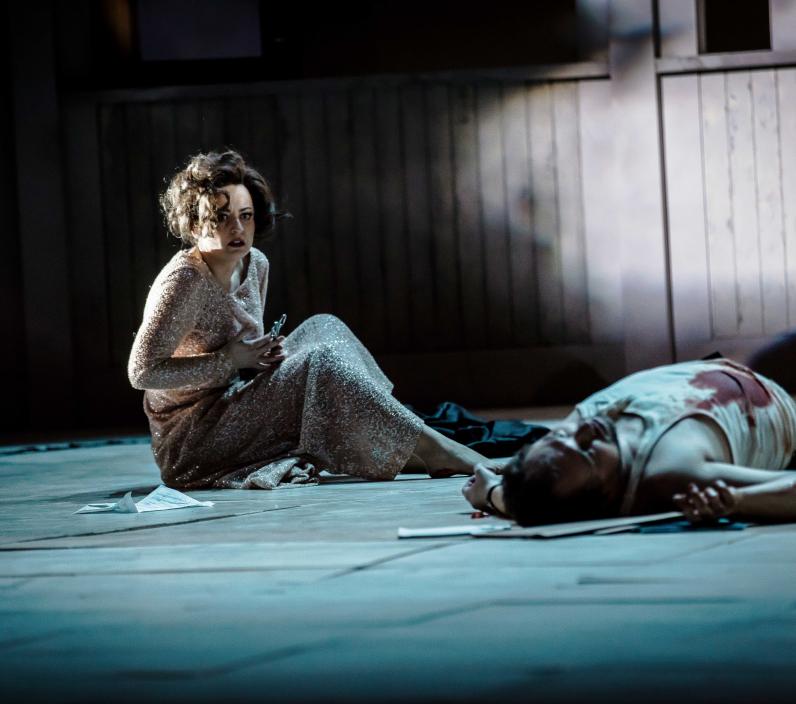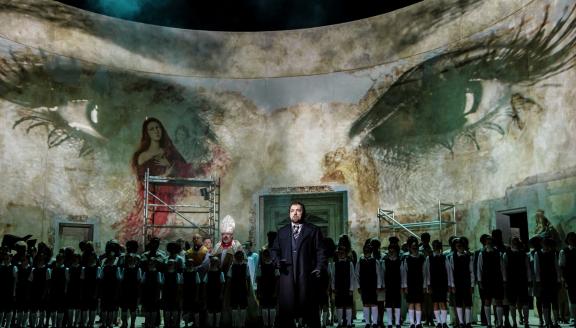

A famous singer lives only for art and love. But when she finds herself caught in a web of politics, corruption, lies and lust, she is forced to make a terrible choice.
Puccini’s timeless opera never ceases to provoke great emotions. Directed by Barbara Wysocka, this new production by Polish National Opera is set in 1970s Rome, a time of escalating political violence, street clashes between rightists, leftists and riot police, bomb attacks, unexplained murders and kidnappings for ransom.
Cast
|
Floria Tosca
|
Ewa Vesin
|
|---|---|
|
Mario Cavaradossi
|
Mickael Spadaccini
|
|
Baron Scarpia
|
Krzysztof Szumański
|
|
Cesare Angelotti
|
Jasin Rammal-Rykała
|
|
Spoletta
|
Mateusz Zajdel
|
|
Sciarrone
|
Adam Kruszewski
|
|
A sacristan
|
José Fardilha
|
|
A jailer
|
Artur Żołnacz
|
|
A shepherd boy
|
Antoni Karaś ('Artos' Choir)
|
|
Chorus
|
Teatr Wielki - Polish National Opera
|
|
Orchestra
|
Teatr Wielki - Polish National Opera
|
| ... | |
|
Music
|
Giacomo Puccini
|
|---|---|
|
Conductor
|
Tadeusz Kozłowski
|
|
Director
|
Barbara Wysocka
|
|
Sets
|
Barbara Hanicka
|
|
Lighting
|
Marc Heinz
|
|
Costumes
|
Julia Kornacka
|
|
Text
|
Luigi Illica & Giuseppe Giacosa
|
|
Chorus master
|
Mirosław Janowski
|
|
Make-Up and Hairstyle Designer
|
Mateusz Stępniak
|
|
Children’s choir master
|
Danuta Chmurska
|
|
Children’s Choir
|
Władysław Skoraczewski 'Artos' Choir and extras
|
|
Casting Director
|
Izabela Kłosińska
|
| ... | |
Video
The story
Act I
9 a.m. Mario Cavaradossi, a painter, is working in a historical chapel, renovating a fresco depicting Mary Magdalene. He does not know that Cesare Angelotti, an escaped prisoner, is hiding in the church. The sacristan helps the painter get set up, then leaves. Thinking he is alone, Angelotti steps out and bumps into Cavaradossi, who promises to help him. Just then, however, the painter’s jealous lover, famous singer Floria Tosca, arrives. Cavaradossi hides the fugitive. Seeing the painter’s confusion, Tosca suspects him of cheating on her. Cavaradossi convinces her of his love and sends her away, then he and Angelotti leave the church.
11 a.m. The sacristan brings news of the alleged victory of the regime’s troops over the revolutionary forces. Orders are given to prepare for the Te Deum and a special evening concert at which Tosca is to sing. Suddenly, Scarpia, Rome’s police prefect, arrives with his men. He searches the church for the runaway prisoner; among many traces of Angelotti’s presence he finds a fan belonging to Countess Attavanti, Angelotti’s sister, who most likely helped her brother to hide.
11:30 a.m. Tosca returns, looking for Cavaradossi, but instead meets Scarpia. He is clearly trying to win her favour and suggests that Cavaradossi is having an affair with Countess Attavanti. This reduces Tosca to rage and despair. When the jealous Tosca runs from the church to have it out with her lover at his villa, Scarpia orders that she be followed. He expresses his desire to have Cavaradossi executed before taking Tosca for himself.
Act II
8 p.m. At the police headquarters in Palazzo Farnese, Scarpia is thinking about Tosca. Spoletta arrives and gives Scarpia a report on the search at Cavaradossi’s villa: he failed to find the fugitive, but he arrested the painter. In another part of the building, Tosca’s concert begins, broadcast on television. Cavaradossi is led in. Asked if he helped Angelotti, he denies it and points out the lack of any evidence.
9 p.m. Her concert having ended, Tosca arrives to find Cavaradossi being led away for interrogation and torture. Blackmailing Tosca with her lover’s suffering, Scarpia tries to get her to tell him where the escaped prisoner is hiding. Under great pressure, Tosca breaks down and betrays the secret: Cavaradossi hid Angelotti in a well in the garden. Sciarrone, one of Scarpia’s thugs, brings news of the defeat suffered by the regime’s forces. Cavaradossi jeers at Scarpia, rejoicing at his defeat. The painter is sentenced to death.
12 midnight. Tosca is alone with Scarpia, who confesses that he has long been watching her and that she is the object of his desire. The shocked Tosca begs him to release Cavaradossi. But the price is high; the singer ultimately agrees to an arrangement in which, in exchange for Cavaradossi’s life and a pass allowing him to leave Rome, she will give herself to Scarpia. Scarpia signs a certificate of safe passage, but as he hands it to Tosca she kills him.
Act III
3 a.m. Cavaradossi awaits his execution at Castel Sant’Angelo. The condemned man refuses to meet with a priest, but wants to write a final letter to Tosca. The singer rushes in and tells her lover about how she killed Scarpia. She instructs Cavaradossi to pretend to fall down dead during his execution by firing squad, which, according to Scarpia’s final order, is to be a hoax.
4 a.m. Cavaradossi is taken to the execution site. Tosca watches as the fake execution is prepared and then carried out. Cavaradossi falls to the ground as planned, but Tosca’s elation turns to despair when she discovers that he is in fact dead and that Scarpia had tricked her after all. The police rush in, having discovered Scarpia’s body. They try to arrest Tosca for committing the murder but she breaks away from the guards and kills herself.
Insights
5 things to know about Tosca
1° Revolution in Rome
Giacomo Puccini's Tosca has been one of the most popular operas in the repertoire ever since its premiere in 1900, just 14 days into the new century. Unlike most operas, it has a precise and concise setting: the action happens in Rome between noon on Tuesday 17th June 1800 and dawn the following day. During those eighteen hours, all the major characters suffer violent deaths.
The real motivations of the characters in Tosca are strictly personal. Nevertheless, the politics and ideals of the time are always in the background. Tosca is set at a critical time in the military campaigns of the French general - and later emperor - Napoleon Bonaparte. The action on stage shows the reactions of the people of Rome to news of Napoleon’s apparent defeat, then actual victory at the Battle of Marengo. It reflects the divided sentiments of the people of Rome, torn between their loyalty to the crown and hopes for new freedoms under a new ruler.
2° Negotiating an adaptation
Puccini’s opera is a violent drama based on Victorien Sardou's hit play La Tosca, which was written as a star vehicle for the famous French actress Sarah Bernhardt. The composer saw La Tosca at least once in Milan and Turin. He wrote to his publisher, Giulio Ricordi, begging him to get Sardou's permission for the work to be made into an opera: "I see in this Tosca the opera I need, with no overblown proportions, no elaborate spectacle, nor will it call for the usual excessive amount of music.” Sardou replied that he would prefer his play to be adapted by a French composer, and he complained about the reception La Tosca received in Italy. Nevertheless, he and Ricordi were able to negotiate acceptable terms.
Puccini visited Sardou in Paris to discuss the adaptation. The composer wanted to replace a patriotic hymn of the imprisoned Cavaradossi in Act III with a love song, which the playwright allowed. But while Sardou wanted an abrupt, thundering finale, Puccini disliked the suicide at the end of the play. He had in mind a different ending, where, rather than leaping, Tosca would go mad, collapse, and die on the body of her lover. Evidently on this particular point the composer lost the argument.
3° Sensual, passionate and murky
Tosca was Puccini’s next opera after his first undisputed success, La bohème. Comparing the two, the composer said: “The colour in Tosca is no longer romantic and lyrical as in La bohème, but sensual, passionate and murky. Scarpia and Spoletta and shady individuals, and the heroes are not as docile as Rodolfo and Mimì, but active and brave".
The plot plays with passions rather than feelings. Tosca is a story of cheating and doubt, where everything - especially love - is troubled by jealousy. Even the marginal characters like the sacristan and the prison guard lie or act dishonestly. Everyone fights deception with deception, which creates a suffocating atmosphere of suspicion and doubt. It is these qualities that place Tosca firmly in the category of verismo opera, a style of Italian realism linked to literary and artistic movements of the same name.
4° Real-life locations
As well as taking place at a specific time, Tosca takes place in three specific, real-life locations: the Basilica di Sant'Andrea della Valle, which is famous for its large painted dome; the Palazzo Farnese, which serves today as the French Embassy; and the Castel Sant’Angelo, which was commissioned by the Roman Emperor Hadrian as a mausoleum for himself and his family then subsequently used as a papal fortress and castle.
A church, a palace and a castle. These are powerful locations built by the great architects of Rome to project the power of her leaders and institutions. Caught in the middle of it all is Floria Tosca, a singer who lives only for art and love – powerful forces in themselves. From the start of Tosca until the last note, opposing forces fight to the death, but they are forces that cannot escape each other for they are eternally bound: love and jealousy; art and deception; the cruel injustice of man and the anticipated justice of God.
5° A director’s dream
In Tosca, a woman falls to her death once she realises that even though she killed her oppressor, she still has failed to save her lover: a triple death entangled in love, lust, politics and power. It’s no wonder that for 120 years the opera has attracted the very best and most visionary directors around.
A multi award-winning actress and director, Barbara Wysocka was honoured with the Paszport Polityki for her 2009 production at Polish National Theatre of Philip Glass' The Fall of the House of Usher. Operas she has directed since then include Gaetano Donizetti’s Lucia di Lammermoor at the Bayerische Staatsoper, Wolfgang Amadeus Mozart’s Don Giovanni at the Bregenzer Festspiele, and her debut on OperaVision, Ludomir Różycki’s Eros & Psyche at Polish National Opera. She sets this new production of Tosca in Rome in the 1970s, a time of escalating political violence, street clashes between rightists, leftists and riot police, bomb attacks, unexplained murders and kidnappings for ransom.
Gallery












